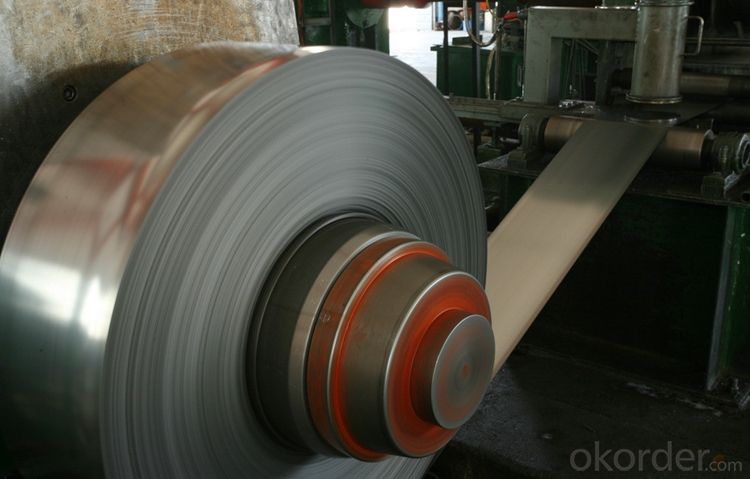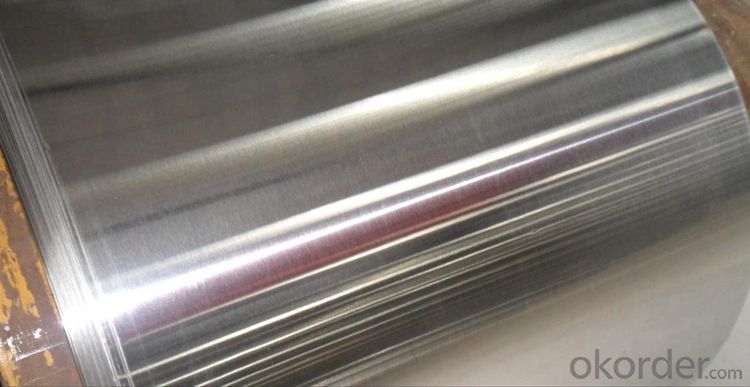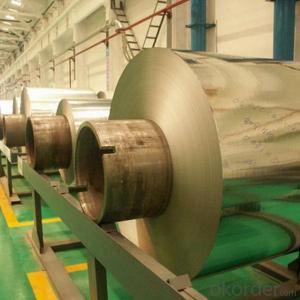Cold Rolled Steel Coils 2B Finish Grade 304 Grade 316 Grade 430
- Loading Port:
- Tianjin
- Payment Terms:
- TT OR LC
- Min Order Qty:
- 50 m.t.
- Supply Capability:
- 20000 m.t./month
OKorder Service Pledge
OKorder Financial Service
You Might Also Like
Item specifice
Specifications for Stainless Steel Coils/Sheets:
Grade | C ≤ | Si ≤ | Mn ≤ | P ≤ | S ≤ | Ni ≤ | Cr ≤ |
201 | 0.12 | 0.75 | 7.00 | 0.045 | 0.045 | 1.00-1.28 | 13.70-15.70 |
202 | 0.15 | 1.00 | 2.25 | 0.045 | 0.045 | 4.07-4.17 | 14.00-16.00 |
304 | 0.08 | 0.75 | 2.00 | 0.045 | 0.03 | 8.00-11.00 | 18.00-20.00 |
304L | 0.035 | 0.75 | 2.00 | 0.045 | 0.03 | 8.00-13.00 | 18.00-20.00 |
309 | 0.15 | 0.75 | 2.00 | 0.045 | 0.03 | 12.00-15.00 | 22.00-24.00 |
310S | 0.08 | 1.50 | 2.00 | 0.045 | 0.03 | 19.00-22.00 | 24.00-26.00 |
316 | 0.08 | 1.00 | 2.00 | 0.045 | 0.03 | 10.00-14.00 | 16.00-18.00 |
316L | 0.035 | 0.75 | 2.00 | 0.045 | 0.03 | 10.00-15.00 | 16.00-18.00 |
321 | 0.04-0.10 | 0.75 | 2.00 | 0.045 | 0.03 | 9.00-13.00 | 17.00-20.00 |
405 | 0.08 | 0.75 | 1.00 | 0.045 | 0.03 | 0.06 | 11.5-13.5 |
409 | 0.089 | 1.00 | 1.00 | 0.045 | 0.05 | 0.06 | 10.50-11.75 |
410 | 0.15 | 0.75 | 1.00 | 0.045 | 0.03 | 0.06 | 11.5-13.5 |
420 | 0.16-0.25 | 1.00 | 1.00 | 0.040 | 0.03 | 0.06 | 12.00-14.00 |
430 | 0.12 | 0.75 | 1.00 | 0.045 | 0.03 | 0.06 | 16.00-18.00 |
Packaging & Delivery for Stainless Steel Coils/Sheets:
Packaging Detail Standard export packing or following customer's demand
Delivery Time: Within 30-40 days after deposit or according to the order quantity
Detail picture for Stainless Steel Coils/Sheets



Application for Stainless Steel Coils/Sheets:
Boiler heat exchanger, machinery andpetroleum ,chemical industries, hardware fields,Food industry,construction material,kitchen utensils, building construction, medical equipment,chemical tank, pipe etc
FAQ for Stainless Steel Coils/Sheets:
Q:How to order?
A: Please send us your purchase order by email or fax .or you can ask us to send you a proforma invoice for your order .We need to know the following information for your order.
1) Shipping information-company name, street address, phone number, fax number, destination sea port
2) Product information – Quantity, Specification (steel type, thickness, width, surface finish)
3) Delivery time required
4) Forwarder's contact details if there's any in China
- Q:What are the common types of corrosion that affect stainless steel sheets?
- The common types of corrosion that affect stainless steel sheets include pitting corrosion, crevice corrosion, stress corrosion cracking, and galvanic corrosion.
- Q:Can stainless steel sheets be used for decorative signage?
- Yes, stainless steel sheets can be used for decorative signage. Stainless steel is a versatile material that can be easily shaped, engraved, and cut to create customized and visually appealing signage. Additionally, stainless steel has a sleek and modern look that can enhance the aesthetic appeal of any space.
- Q:Are stainless steel sheets resistant to alkaline solutions?
- Generally, stainless steel sheets are resistant to alkaline solutions. They have a reputation for being corrosion-resistant and can tolerate exposure to various chemicals, including alkalis. The protective oxide layer on the surface, formed by the high chromium content in stainless steel, aids in preventing corrosion and deterioration. However, it's worth noting that the resistance of stainless steel to alkaline solutions may differ depending on the specific grade and composition. In certain instances, prolonged exposure to highly concentrated alkaline solutions or aggressive alkaline substances could potentially harm the stainless steel surface. Therefore, it is advisable to consult the manufacturer or supplier to ensure the appropriate grade of stainless steel is chosen for specific alkaline applications.
- Q:Can stainless steel sheets be used for elevator cladding?
- Yes, stainless steel sheets can be used for elevator cladding. Stainless steel is a popular choice for elevator cladding due to its durability, aesthetic appeal, and resistance to corrosion and staining. It provides a sleek and modern look while also offering protection against wear and tear in high-traffic areas.
- Q:What is stainless steel plate wire?
- But in the stainless steel industry said decimillimeter, such as stainless steel plate with the thickness of 1mm, the tolerance of 0.91 plus or minus 1 wire, a tolerance of plus or minus 0.01mm 0.91mm. That is to say here is actually in mathematics centimillimeter decimillimeter.1 wire =0.01 mm
- Q:Can stainless steel sheets be used for medical sterilization equipment?
- Certainly, medical sterilization equipment can indeed utilize stainless steel sheets. Due to its exceptional resistance to corrosion, impressive heat resistance, and remarkable durability, stainless steel stands as a favored material choice within the medical industry. These remarkable attributes render stainless steel sheets perfectly suited for a wide array of medical applications, including the construction of sterilization equipment. With the ability to endure high temperatures and endure multiple sterilization cycles without warping or deteriorating, stainless steel sheets prove themselves suitable for autoclaves and other sterilization devices. Moreover, stainless steel's effortless cleaning and maintenance capabilities play a critical role in preventing the proliferation of bacteria and other harmful microorganisms. As a result, stainless steel sheets find widespread usage in medical settings where the presence of sterilization equipment is imperative.
- Q:Can stainless steel sheets be used for medical implant devices?
- Yes, stainless steel sheets can be used for medical implant devices. Stainless steel is a widely used material in the medical industry due to its excellent mechanical properties, corrosion resistance, and biocompatibility. It is known for its strength, durability, and ability to withstand sterilization processes. Stainless steel sheets can be fabricated into various medical implant devices such as plates, screws, and pins used in orthopedic surgeries, dental implants, cardiovascular devices, and many others. The high strength-to-weight ratio of stainless steel makes it suitable for load-bearing applications, while its resistance to corrosion ensures longevity within the body. Furthermore, stainless steel is a biocompatible material, which means it is well-tolerated by the human body and does not cause adverse reactions or allergies. The surface of stainless steel can be modified to enhance its biocompatibility by processes like passivation or coating. It is important to note that the selection of the appropriate stainless steel grade and surface finish is crucial for medical implant devices to ensure compatibility with the specific body tissue and environment. Additionally, thorough testing and regulatory approval are required to ensure the safety and efficacy of stainless steel medical implant devices. In conclusion, stainless steel sheets can indeed be used for medical implant devices due to their mechanical properties, corrosion resistance, and biocompatibility. Proper selection, testing, and regulatory approval are essential to ensure the suitability and safety of stainless steel implants in medical applications.
- Q:What are the benefits of using etched stainless steel sheets in signage?
- Using etched stainless steel sheets in signage comes with numerous advantages. Firstly, these sheets are incredibly durable and long-lasting due to stainless steel's resistance to corrosion, rust, and fading. This makes them perfect for outdoor signage that is exposed to harsh weather conditions. Secondly, etched stainless steel sheets provide a sleek and professional look. Through the process of etching, intricate designs, logos, and text can be permanently engraved onto the surface of the stainless steel. This results in a visually appealing finish that adds sophistication to any signage. Additionally, etched stainless steel sheets are highly customizable, allowing them to meet specific design requirements. This versatility makes them suitable for a wide range of signage applications such as architectural signage, company logos, directional signs, or wayfinding systems. They can be tailored to match any style or branding. Moreover, stainless steel is easy to clean and maintain. Simply wiping it down with a cloth or using mild soap and water will keep the signage in pristine condition for an extended period. This low maintenance requirement is particularly advantageous for outdoor signage that may require regular cleaning. Lastly, etched stainless steel sheets offer excellent visibility. By filling the engraved designs on the stainless steel surface with paint or other materials, the signage becomes highly visible even from a distance or in low light conditions. This enhanced visibility ensures that the intended message or information is effectively communicated to the target audience. In conclusion, the use of etched stainless steel sheets in signage provides durability, a professional appearance, customization options, easy maintenance, and excellent visibility. These advantages have made etched stainless steel sheets a popular choice for signage applications across various industries.
- Q:Are stainless steel sheets suitable for elevator flooring?
- Yes, stainless steel sheets are suitable for elevator flooring. They are durable, resistant to corrosion, easy to clean, and provide a sleek and modern look that complements the interior design of elevators.
- Q:How do you drill holes in stainless steel sheets?
- To achieve accurate and clean results, it is necessary to follow specific steps and use the right tools when drilling holes in stainless steel sheets. Here is a detailed guide on how to accomplish this task: Step 1: Gather the required tools, including a drill machine, suitable drill bits for stainless steel (cobalt or carbide are recommended), a center punch, safety goggles, work gloves, and a clamp or vise to secure the stainless steel sheet. Step 2: Select the appropriate drill bit. Since stainless steel is a tough material, regular drill bits may not be effective. Instead, opt for cobalt or carbide drill bits that are specifically designed for cutting through hard metals. Step 3: Mark the hole position by using a center punch to create a small indentation at the exact spot where you intend to drill. This will prevent the drill bit from slipping when starting the hole. Step 4: Firmly secure the stainless steel sheet using a clamp or vise on a workbench or surface. This will prevent any movement during drilling and ensure precise and clean holes. Step 5: Prioritize safety by wearing safety goggles and work gloves to protect your eyes and hands from metal debris and sharp edges. Step 6: Begin drilling by placing the drill bit on the marked indentation and applying gentle pressure to start the hole. Use a lower speed setting on your drill machine to prevent overheating, gradually increasing the pressure as you continue drilling. Step 7: Apply cutting fluid or lubricant on the drill bit while drilling to reduce friction and heat buildup. This will extend the life of the drill bit and prevent discoloration or warping of the stainless steel sheet due to excessive heat. Step 8: Monitor the drilling progress and adjust the speed and pressure accordingly. It is crucial to maintain a steady pace and avoid applying excessive force to prevent drill bit breakage or damage to the stainless steel sheet. Step 9: Periodically stop drilling to remove metal debris from the hole, ensuring that it does not clog and that the hole remains clean. Step 10: Once the desired hole size is achieved, slowly withdraw the drill bit from the stainless steel sheet. Use a file or deburring tool to smooth out any rough edges around the hole. By following these steps and utilizing the appropriate tools, you can successfully drill precise and clean holes in stainless steel sheets. Remember to take your time, prioritize safety, and properly maintain your tools for optimal results.
1. Manufacturer Overview |
|
|---|---|
| Location | |
| Year Established | |
| Annual Output Value | |
| Main Markets | |
| Company Certifications | |
2. Manufacturer Certificates |
|
|---|---|
| a) Certification Name | |
| Range | |
| Reference | |
| Validity Period | |
3. Manufacturer Capability |
|
|---|---|
| a)Trade Capacity | |
| Nearest Port | |
| Export Percentage | |
| No.of Employees in Trade Department | |
| Language Spoken: | |
| b)Factory Information | |
| Factory Size: | |
| No. of Production Lines | |
| Contract Manufacturing | |
| Product Price Range | |
Send your message to us
Cold Rolled Steel Coils 2B Finish Grade 304 Grade 316 Grade 430
- Loading Port:
- Tianjin
- Payment Terms:
- TT OR LC
- Min Order Qty:
- 50 m.t.
- Supply Capability:
- 20000 m.t./month
OKorder Service Pledge
OKorder Financial Service
Similar products
New products
Hot products
Related keywords

































